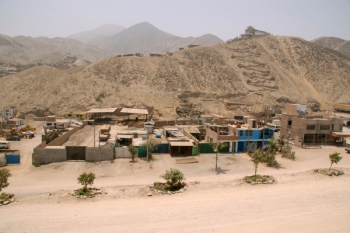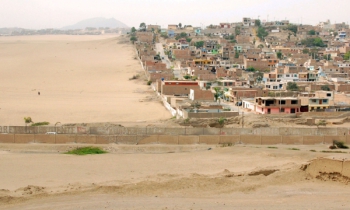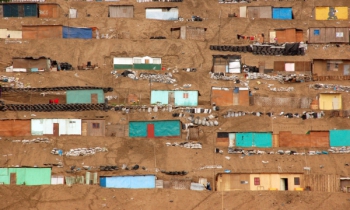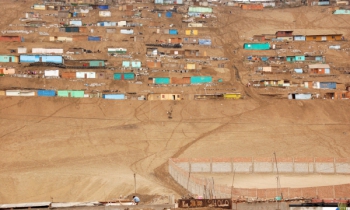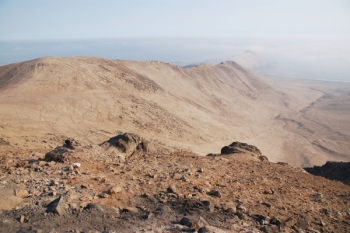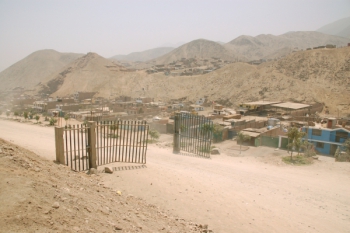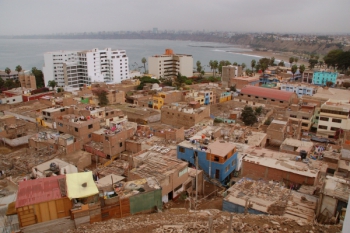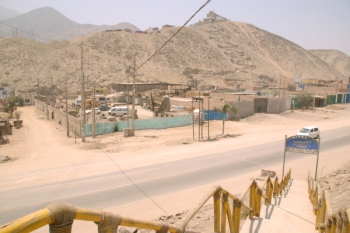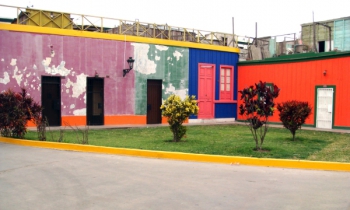Lima-a-mil
Societies in transition - Phoenix – destruction, reconstruction, dream
The Capital City of Peru, a City in the desert of the Andean foothills. Towns and cities of the world grow at unprecedented rates setting the social, political, cultural and environmental trends. In 1950, one-third of the world’s people lived in cities. Just 50 years later, this proportion has risen to one-half and will continue to grow to two-thirds by 2050.
The series of photographs entitled Lima-a-mil, literally "Lima at one thousand". The title of each photograph indicates a precise location, where a particular shot was taken as part of an itinerary designed in order to compose a portrait of Lima viewed from the outskirts. The sequence as a whole evinces the disparities between 'haves' and 'have-nots', the urban asymmetries unintentionally created by the desire of people to enjoy better opportunities in the city. and the incongruities that result when life has to be constantly improvised in a Megapolis that has a population of more than eight million people.
Limited Edition #10 Photographs on AluDibond Print 120 X 90 cm 1800 Euro
Book Publication: Franziska Agrawal. LIMA A MIL, Blurb.de, 2010
The World Bank Art Collection, The Cultural Center of the Inter-American Development Bank (IADB) and AMA - the Art Museum of the Americas, Organization of the American States (OAS), April 2012: "Nourished by the profound differences among their diverse cultural and ethnic heritages, the Photos reflect clearly their unique cultural references, history and traditions. At the same time, they resonate with shared transnational themes and tell the viewer as much about the region as the Bank’s annual report, but in a different manner. They talk about regional priorities and the impact of international emergencies, such as the food price crisis, migration, climate change, and social inequality, but there are also stories of resilience, humor and universalities of our human condition. Not unlike social workers and visionaries, Agrawal calls on viewers and society to engage in hard self-reflection."
Urban Landscapes
It is the strong contrast that astonish and come up with the idea of digital manipulation. Because the images extract themselves beyond the usual pattern of landscape and urban photography. Represented would be those boundaries between the sometimes wild and seemingly chaotic landscape and sometimes more, sometimes less orderly urban structures - seemingly archaic settlements, functional shacks in combination with ancient cult sites and landscapes, which would obviously taken from the sprawling settlements. Dwellings that stick like swallows' nests on sharp rocks; Houses, growing like a mirage from the desert. Distance is very adept chosen for the shots taken, which provides an overview and doesn't get the viewer too caught up in details. A distant, yet intense view on a seemingly contradictory constellation of houses and landscapes, which are charged by a cultural-historical energy. What is the main motive in these pictures? What is the marginal? As far as we can decode these complex images using not only visual, but also substantive experience? Although these photographs have indisputable visual quality, it quickly becomes clear by their complexity, that Agrawal is also looking for a solution to various philosophical issues through those images and that the basis of her work is very broad. Over 3 years Agrawal has been working on this series and made numerous trips to places where the past and present, landscape and urbanism, culture and sometimes infernal acting, densely populated regions of the great metropolis collide and again new sediments are formed as the basis of future generations. Agrawal images are classic and abstract at the same time. They act as utopias, yet are still strictly documentary, thoughtful and geometric elated.
Urbane Landschaften und Gesellschaften im Wandel - Phönix – Zerstörung, Wiederaufbau, Traum -
Es ist der starke Kontrast, der überrascht und die Gedanken an digitale Manipulation aufkommen lässt. Denn die gebotenen Bilder entziehen sich dem gewohnten Muster von Landschafts- aber auch Stadt Fotografie. Dargestellt würden jene Grenzen zwischen der zum Teil wild und chaotisch anmutenden Landschaft und mal mehr, mal weniger geordneten urbanen Strukturen – archaisch wirkenden Siedlungen, zweckmäßige Hüttenbauten in Kombination mit antiken Kultstätten und Landschaften, die sichtlich von den sich ausbreitenden Siedlungen eingenommen würden. Behausungen, die wie Schwalbennester an schroffen Felsen kleben; Wohnhäuser, die wie eine Fata Morgana aus den wüsten wachsen. Für die Aufnahmen sind sehr geschickt die Distanz gewählt, die Übersicht bietet und den Betrachter nicht zu sehr in Details verwickelt. Ein distanzierter, dennoch intensiver Blick auf widersprüchlich anmutende Konstellation von Häusern und Landschaften, die von einer kulturell-historischen Energie aufgeladen werden. Was ist in diesen Bildern das Hauptmotiv? Was ist die Marginalie? Wie weit können wir diese komplexen Bilder dekodieren und nicht nur als visuelle, sondern auch inhaltliche Erfahrung nutzen? Obgleich diese Fotografien unbestreitbare visuelle Qualität aufweisen, wird durch ihre Komplexität schnell klar, dass Agrawal mit ihnen auch nach der Lösung verschiedener philosophischer Fragen sucht und die Basis ihrer Arbeit sehr weit gefasst ist. Über 3 Jahre arbeitet Agrawal an dieser Serie und unternahm zahlreiche Reisen an Orte, wo Geschichte und Gegenwart, Landschaft und Urbanität, Kultur und die manchmal infernal wirkende, verdichtete Räume der großen Metropole aufeinanderprallen und wieder neue Sedimente als Basis der nächsten Generationen gebildet werden. Agrawals Bilder sind klassisch und abstrakt zugleich. Wirken wie Utopien, sind dennoch streng dokumentarisch, nachdenklich und geometrisch beschwingt.
bienvenidos a la planicie



